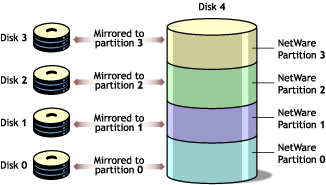6.1 Planning Your Software RAID1 Device
Mirroring is a software RAID1 technique that writes data in parallel to multiple separate devices. If one device fails, the other member devices remain available.
You can create a software RAID1 device with up to four member partitions, including the original partition and up to three mirrored partitions. Each member partition resides on a separate server disk.
As contrasted to a hardware RAID1 device, the server operating system controls the mirroring activity in a software RAID1 device, which can slightly impact the CPU performance for the server. Adding additional mirrors after the first contributes to availability, but it also incrementally impacts CPU performance.
Typically, you write only to the original partition and send duplicate writes to the mirrored partitions. However, you can read from all member partitions. This improves the read performance of your Traditional volumes that contain volume segments in member partitions of the RAID.
This section discusses the following considerations for achieving fault tolerance:
6.1.1 Fault Tolerance for Traditional Volumes
If you mirror one partition, you do not necessarily provide data protection for the entire volume. To create software RAID1 devices for Traditional NetWare partitions, you must keep in mind the relationship between Traditional NetWare partitions, volumes, and volume segments. (For information about these key concepts, see Section 1.0, Overview of the NetWare Traditional File System.)
NetWare partitions consist of up to 8 volume segments. Each segment can be allocated separately as a member of a different Traditional volume. If you mirror a partition, the volume segments it contains are mirrored on the mirror partition. For a Traditional volume that spans multiple server disks, only its volume segments in that particular partition are mirrored. The volume segments on other partitions on the same or different server disks remain unprotected. To fully protect your Traditional volume, you must create a RAID1 device for each Traditional NetWare partition that contains one of the volume’s segments.
6.1.2 Key Concepts for Mirroring Traditional NetWare Partitions
The following are important concepts for mirroring Traditional NetWare partitions:
-
All member partitions of a software RAID1 device must be of the same type. A Traditional NetWare partition can only be mirrored to other Traditional partitions.
-
Each member partition in the software RAID1 device must be compatible in data area size.
The new partition must be at least the same size or slightly larger than the other partitions in the group. The physical size of the partition must be at least 100 kilobytes (KB), but no more than 120 megabytes (MB) larger than the data size of the existing partitions in the mirror group.
-
All member partitions in the software RAID1 device must have the same sharable status. Either all are sharable for clustering, or all are not.
-
Partitions you add to the software RAID1 device cannot be members of any other software RAID device. They must be standalone partitions.
-
Only partitions marked with the Mirror attribute can be used as a software RAID1 mirrored partition. You must set the Mirror attribute for partitions when you create them; you cannot add the option later.
-
Although you can mirror one partition to as many as four other partitions, mirroring two partitions is typically sufficient fault tolerance for most systems.
-
If a mirrored disk fails and cannot be accessed by the server, you can unmirror the server’s partitions on the functional disk, then salvage the lost volume segments.
-
If you want to remove a hot-plug mirrored disk without bringing down the server, you must unmirror the disk first.
6.1.3 Improving Fault Tolerance for Software RAID1 Devices with Duplexing
Mirroring stores the same data on separate disks on the same controller channel. If you mirror partitions on separate disks over different controller channels or host bus adapters, this is called duplexing. Duplexing can also concurrently use two instances of a driver for the channels. Duplexing is the recommended method for fault tolerance because two channels rarely fail simultaneously.
The process for mirroring and duplexing is the same. The term mirroring is used in all menus in Novell Remote Manager for NetWare to refer to both mirroring and duplexing.
6.1.4 Example Software RAID1 Solution for Fault Tolerance of Traditional Volumes
As an example, consider a server that has five server disks. Four of the disks (0, 1, 3, and 4) are under 4 gigabytes (GB) and each disk contains a single partition the size of the disk. The fifth disk (5) is 20 GB and contains four partitions of 4 GB each; the remaining 4 GB capacity are unused free space. Each physical NetWare partition is further subdivided into eight volume segments of about 500 MB each. The first four disks contain 32 volume segments that can be allocated to up to 32 separate Traditional volumes. (4 disks x 1 partition per disk x 8 volume segments per partition = 32 volume segments) You choose to create 8 Traditional volumes, each with 4 segments that span the four disks.
For data fault tolerance, you create four software RAID1 mirrored partitions on the fifth server disk, where the other device’s partition are mirrored separately. In Figure 6-1, single partitions on several smaller disks are mirrored to similarly sized partitions on one larger disk. In this configuration, if any of the small disks fail, the data on the volume segments can be recovered from the mirrored partition. However, if the large server disk fails, all of the mirrored partitions would also fail. The original data would not be harmed.
Figure 6-1 Mirroring Small Disks to Partitions on One Large Disk
